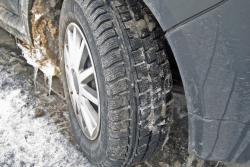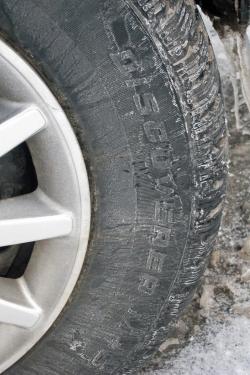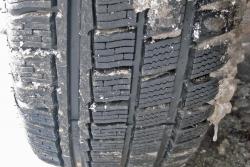Review and photos by Paul Williams
If you want to test a winter tire, then January and February in eastern Canada is the time and place to do it. The winter of 2013-2014, however, is extraordinary; extreme even for Canadians. Here in Ottawa we’ve seen sustained night-time temperatures of –30 degrees and daytime highs struggling to reach –25.
Then it’s above zero for a day – a 30-degree increase! – allowing everything to melt into a slippery, greasy mess. This followed by rain and a plunge in temperature to freeze everything into slick surfaces that resemble an ice rink (add 60 km/h winds and you might be amused to see Canadians inelegantly blown down sidewalks and across roads… it’s actually not that funny!).
In other words, this is a place where you don’t want, but need winter tires. In fact in Quebec, right next door to Ottawa, their use is mandatory from December to March.
   Cooper Discoverer M+S Sport. Click image to enlarge |
Cooper Tires Discoverer M+S Sport is a new tire that’s designed to handle all of the above conditions. The Discoverer M+S Sport is Cooper’s premium studless SUV/CUV winter tire; engineered, according to the company, “for drivers looking for excellent traction on snow and ice.” Cooper advertising presents this tire fitted to vehicles like an Audi Q5, for instance, emphasizing its suitability for use on higher performance and/or luxury SUVs or crossovers.
The Discoverer M+S Sport features a directional tread pattern to “more effectively evacuate water from the contact area,” a central rib designed to provide “crisp, responsive steering,” and “snow groove” technology designed to “help you plough through snow and ice.” The tire’s tread design incorporates “biting edges” that enhance grip, according to Cooper Tires.
The company’s UK website says of the Discover M+S Sport that its silica compound, “capitalizes on the higher traction characteristics of ‘snow on snow’ versus ‘snow on rubber,’” and I asked for clarification about this. Turns out this is the above-mentioned “snow groove” effect, explained by Cooper Tires as follows:
Water/Snow/Ice (any H2O combination) make a great lubricant for rubber but a very poor friction enhancer. Snow sticking to snow: now that’s the snowball effect. [It] sticks together and that’s the concept of Snow Groove; try to retain as much snow in the tire as possible to improve traction on snow. The snow in the tread sticks to the snow on the road surface which allows for better grip when accelerating or braking.
The Discoverer M+S Sports replaced a set of Gislaved winter tires on my Honda SUV that had seen two winters of light use. This vehicle is not heavily driven (as an auto writer, I’m usually driving test vehicles, so my personal vehicle does only about 10,000 km per year, maximum) and its winter tires were in excellent condition, although granted, not new.
After having the 215/70-16 (original equipment specification) Cooper tires mounted at Nepean’s Clyde Avenue Frisby Tire Centre, the change in vehicle dynamics was surprising and obvious. The first observation was that when cornering, the vehicle felt more stable, less inclined to slide. Handling, in other words, was improved, making even the humble Element feel more responsive, and its driver feel more confident when changing directions.









